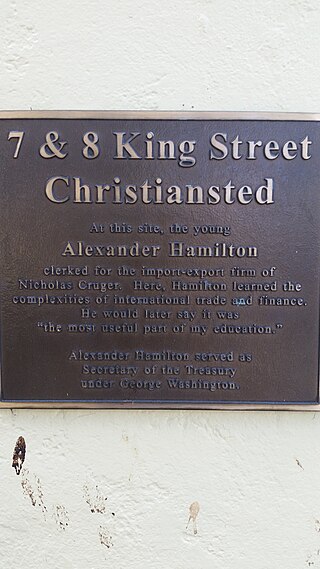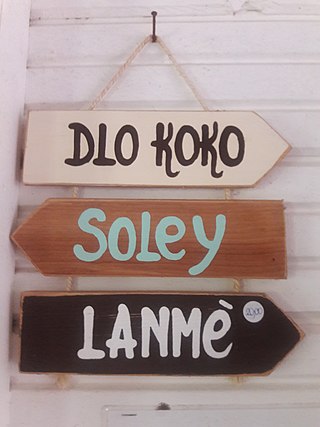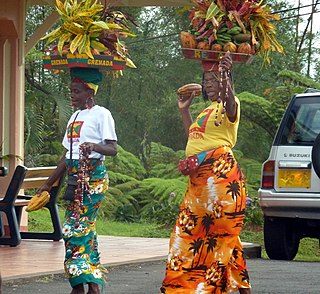| Total population | |
|---|---|
| Regions with significant populations | |
| |
| Languages | |
| Grenadian Creole, American English | |
| Religion | |
| Predominantly Roman Catholicism |
Grenadian Americans are Americans whose ancestry came from the Caribbean island of Grenada, or Grenadians who have American citizenship. Since 1984, nearly 850 Grenadians arrive legally in the United States each year, and the number of Grenadian Americans was 25,924 in 2000. [1] They began immigrating to the US primarily from 1950. Between 2007 and 2011, there were approximately 30,320 Grenadian-born residents in the United States. [2]
The Grenadian migration to the United States began in the first half of the twentieth century. Grenadians first settled in cities of the northeastern US, primarily in New York and Boston. Between 1900 and 1940 the number of Grenadians who immigrated to the US did not reach a thousand.
Grenadian immigration to the US increased only from the 1950s, after World War II. This increase was due to female migration at the end of the decade. However, few Grenadians were allowed to immigrate to the US legally. Grenadian women often worked as nurses or maids. In the mid-1950s, "when oil refineries were machined" in Grenada and had reduced their operating income, the US allowed a group of oil workers from Grenada to immigrate to this country. These Grenadians managed to immigrate to the US legally by various means. Some had managed to establish relationships with important people from the oil companies, in which they worked, or the naval base of other Caribbean places, particularly in Chaguaramas, Trinidad, and their bosses recommended them to American employers. Others enrolled their children at US schools, and when they got jobs and came into contact with people who "help them with immigration requirements", they asked that their parents obtain a legal status to live in the U.S. Others originally immigrated to England or to the United States Virgin Islands, where they worked in oil refineries, to emigrate from there (most of them crossing Canada), to the United States.
Canada sponsored labor courses to train women in domestic service (which lasted two years) in the Caribbean. After finishing the courses, these women were able to migrate to the United States, although only a few hundred of them did so. They immigrated to places such as Washington, DC, New York, and Boston. In the 1960s, the US favored the immigration of Caribbean maids to the United States. Hundreds of women from Grenada immigrated to the US to work in domestic service in the Northeast, mainly in New York.
Following the adoption of the Hart-Celler Immigration Reform, 1965, the number of Grenadians who moved to this country increased. This law replaced the mass European immigration to the US by the Caribbean.
Between 1960 and 1980, 10,391 Grenadians immigrated to the US legally.
In the 1970s and 1980s, many Grenadians who moved to the US did that for political reasons. They rejected the change of politicians in Grenada, since the policies exercised by the government of Grenada were being influenced by communism. [3]
Immigration from Grenada to the United States also took place between 2004 and 2005 after Hurricane Ivan and Hurricane Emily Struck Grenada. In September 2009, an American of Grenadian descent, Jumaane Williams, became the first Grenadian-American in New York City's Council. [4]
It is documented that from 1900 to 2019 roughly around 22,000 - 32,000 Grenadians immigrated to the United States of America.
Since 1984 about 850 Grenadians immigrate legally to the United States annually. At present, the number of Grenadians who can immigrate to the US legally is far fewer than Europeans. However, the number of Grenadians that might come, exceed the allowed number of the same group at the beginning of the century.
Although the majority language is English, many Grenadian Americans also speak their "creole" or "broken Creole, a combination of French, Inglés, and African patois.
Although Grenadian immigrants retain the traditional customs of Grenada, the second generation of Grenadine Americans onwards have adapted to the American culture, mainly to the African American one, since most of them live in African American neighborhoods.
However (and in spite of that) the relations between the Grenadian Americans and their land of origin have been maintained. Even, many Grenadian associations were founded with the purpose of helping Grenada economically.
New York is the main destination of Grenadian immigration in the world. [3]
Most Grenadian Americans descend from Africans imported to Grenada as slaves. The rest of the Grenadians are mulattos (i.e. the result of a mix between whites and blacks), descendants of East Indians (who migrated as cheap labor in the 19th century after slavery was abolished), and whites of European descent. Many Grenadians immigrated to African American neighborhoods. [3]
Education is very important for Grenadian Americans, as it is a way to prosper. Thus, they attend school every day, meeting US law. Most Grenadian Americans are (or were) enrolled in public schools. There are also many adult Grenadians who have decided to study for technical training or finish high school. A growing number of Grenadians attend college in the US. Although many Grenadians come to the US to study and get better employment opportunities in Grenada in the future, they end up settling permanently in the US, and raising a family. Some do return to Grenada to help their compatriots. [3]
Grenadian Americans still retain strong ties to Grenada, and know much of the politics of their country, which is received by radio, newspapers and television. They also gather information through telephone communication with family and friends who still live there.
Most Grenadian Americans defended the American invasion of Grenada in 1983 because they believed that, in this way, the US could restore democracy in that country.
The Grenadians living in the US tend to help people who still live in their country of origin. On 28 January 1999, a press release was issued by the office of the Prime Minister of Grenada which indicated that just the day before, nearly 300 Americans had met with Grenadian Prime Minister Keith Mitchell in the American city of Boston, to ask how they could participate in the development of Grenada. He explained that they should adopt the educational institutions, supply of equipment and technical development of Grenada to facilitate the work of the Grenadians. Thus, the Grenadian Americans introduced a school in Grenada and "donate equipment and supplies" annually. [3]

The demography of the population of Grenada includes population density, ethnicity, education level, health of the populace, economic status, religious affiliations and other aspects of the population.

Saint Croix is an island in the Caribbean Sea, and a county and constituent district of the United States Virgin Islands (USVI), an unincorporated territory of the United States.

The French West Indies or French Antilles are the parts of France located in the Antilles islands of the Caribbean:

Sir Eric Matthew Gairy PC was the first Prime Minister of Grenada, serving from his country's independence in 1974 until his overthrow in a coup by Maurice Bishop in 1979. Gairy also served as head of government in pre-independence Grenada as Chief Minister from 1961 to 1962, and as Premier from 1967 to 1974.

The region known as Hispanic America and historically as Spanish America is all the Spanish-speaking countries of the Americas. In all of these countries, Spanish is the main language - sometimes sharing official status with one or more indigenous languages or English, and Roman Catholicism is the predominant religion.

Antillean Creole is a French-based creole that is primarily spoken in the Antilles. Its grammar and vocabulary include elements of French, Carib, English, and African languages.
Afro-Caribbean people or African Caribbean are Caribbean people who trace their full or partial ancestry to sub-Saharan Africa. The majority of the modern Afro-Caribbean people descend from the Africans taken as slaves to colonial Caribbean via the trans-Atlantic slave trade between the 15th and 19th centuries to work primarily on various sugar plantations and in domestic households. Other names for the ethnic group include Black Caribbean, Afro or Black West Indian or Afro or Black Antillean. The term Afro-Caribbean was not coined by Caribbean people themselves but was first used by European Americans in the late 1960s.

Callaloo is a plant used in popular dishes in many Caribbean countries, while for other Caribbean countries, a stew made with the plant is called callaloo. Cuisines including the plant Callaloo or dishes called callaloo varies throughout the Caribbean. Countries like Jamaica and Belize refer to an indigenous green leaf vegetable, Caribbean amaranth, as callaloo. In countries such as Trinidad and Tobago or Grenada, the dish itself is called callaloo, and uses taro leaves or Xanthosoma leaves.

The United States has a racially and ethnically diverse population. At the federal level, race and ethnicity have been categorized separately. The most recent United States census recognized five racial categories, as well as people who belong to two or more of the racial categories. The United States also recognizes the broader notion of ethnicity. The 2000 census and 2010 American Community Survey inquired about the "ancestry" of residents, while the 2020 census allowed people to enter their "origins". The Census Bureau also classified respondents as either Hispanic or Latino, identifying as an ethnicity, which comprises the minority group in the nation.

The People's Revolutionary Government (PRG) was proclaimed on 13 March 1979 after the Marxist–Leninist New Jewel Movement overthrew the government of Grenada in a revolution, making Grenada the only socialist state within the Commonwealth. In Grenada, the revolution is referred to as the March 13th Revolution of 1979. The government suspended the constitution and ruled by decree until a factional conflict broke out, culminating in an invasion by the United States on 25 October 1983.
Haitian Americans are a group of Americans of full or partial Haitian origin or descent. The largest proportion of Haitians in the United States live in Little Haiti to the South Florida area. In addition, they have settled in major Northeast cities such as New York City, Boston, Philadelphia, Baltimore and Washington, D.C., and in Chicago and Detroit in the Midwest. Most are immigrants or their descendants from the mid-late 20th-century migrations to the United States. Haitian Americans represent the largest group within the Haitian diaspora.
The Southern Caribbean is a group of islands that neighbor mainland South America in the West Indies. Saint Lucia lies to the north of the region, Barbados in the east, Trinidad and Tobago at its southernmost point, and Aruba at the most westerly section.

Caribbean Americans or West Indian Americans are Americans who trace their ancestry to the Caribbean. Caribbean Americans are a multi-ethnic and multi-racial group that trace their ancestry further in time mostly to Africa, as well as Asia, the Indigenous peoples of the Americas, and to Europe. As of 2016, about 13 million — about 4% of the total U.S. population — have Caribbean ancestry.
Trinidadian and Tobagonian Americans are people with Trinidadian and Tobagonian ancestry or immigrants who were born in Trinidad and Tobago. Trinidad and Tobago is home to people of many different national, ethnic and religious origins. As a result, people of Trinidadian and Tobagonian descent do not equate their nationality with ethnicity. The largest proportion of Trinidadians lives in the New York metropolitan area, with other large communities located in South Florida, Central Florida, Pennsylvania, Maryland, Texas, Minnesota, Georgia, and Massachusetts. There are more than 223,639 Trinbagonian Americans living in the United States.
Indo-Grenadians or Grenadians who trace their roots to India, form the largest minority group in Grenada. This term is not generally recognized by Grenadians or indeed Caribbeans. They usually refer to themselves simply as Grenadian or possibly Caribbean. This group was first introduced during the second half of the 19th century when Grenada experimented with indentured labour. By the second half of the 20th century Indians were so integrated into Grenada’s society that a distinct Indian cultural identity was generally invisible. In addition, Indians were involved in every aspect of Grenadian life. Currently there are over 12,000 Grenadians of Indian and mixed-Indian descent.

Grenada – United States relations are bilateral relations between Grenada and the United States. The United States recognized Grenada on the 7 February 1974, as the same day as Grenada got independence from the United Kingdom of Great Britain and Northern Ireland. These nations formally established diplomatic relations on 29 November 1974.

Grenada is an island nation of the West Indies in the eastern Caribbean Sea. The southernmost of the Windward Islands, Grenada is directly south of Saint Vincent and the Grenadines and about 100 miles north of Trinidad and the South American mainland.

Afro-Grenadians or Black Grenadians are Grenadian people of largely African descent. This term is not generally recognised by Grenadians or indeed Caribbeans. They usually refer to themselves simply as Black or possibly Black Caribbean. The term was first coined by an African Americans history professor, John Henrik Clarke (1915–1998), in his piece entitled A Note on Racism in History. The term may also refer to a Grenadian of African ancestry. Social interpretations of race are mutable rather than deterministic and neither physical appearance nor ancestry are used straightforwardly to determine whether a person is considered a Black Grenadian. According to the 2012 Census, 82% of Grenada's population is Black, 13% is mixed European and black and 2% is of Indian origin.

Immigration to Venezuela historically has been significant. Because of the Venezuelan geographical location as a gateway to South America, this nation has been the plot for many newcomers, even taking place before Columbus' discovery in 1498 when many aboriginal inhabitants came and left Venezuela. After the Spanish colonization of the Americas brought European colonists and African slaves, immigration to Venezuela was significant particularly in the period after World War II, with large numbers of immigrants from Asia and Europe, particularly southern Europe. In addition, Venezuela shares a 1000-mile border with Colombia and has long had substantial numbers of Colombian residents. Since the 1980s, the Colombian conflict has seen largescale Colombian immigration, with Venezuela the number one destination for displaced Colombians.

Grenadian nationality law is regulated by the 1973 Grenadian Constitution, as amended; the Citizenship Act of 1976, and its revisions; and various British Nationality laws. These laws determine who is, or is eligible to be, a national of Grenada. Grenadian nationality is typically obtained either on the principle of jus soli, i.e. by birth in Grenada; or under the rules of jus sanguinis, i.e. by birth abroad to parents with Grenadian nationality. It can also be granted to persons with an affiliation to the country, or to a permanent resident who has lived in the country for a given period of time through naturalisation. There is also, currently a program in Grenada for persons to acquire nationality through investment in the country. Nationality establishes one's international identity as a member of a sovereign nation. Though it is not synonymous with citizenship, for rights granted under domestic law for domestic purposes, the United Kingdom, and thus the Commonwealth, have traditionally used the words interchangeably.